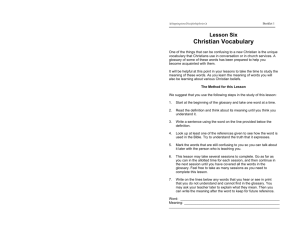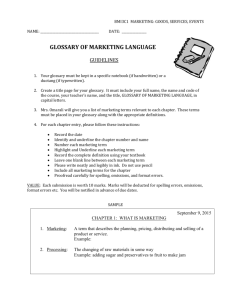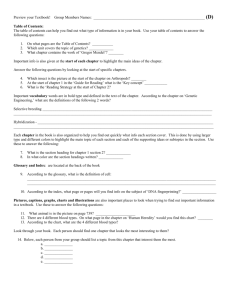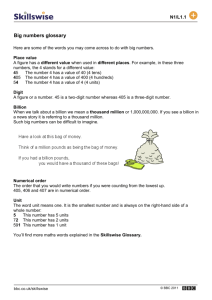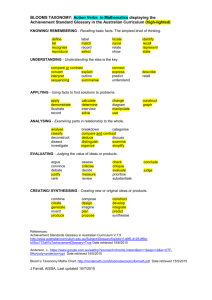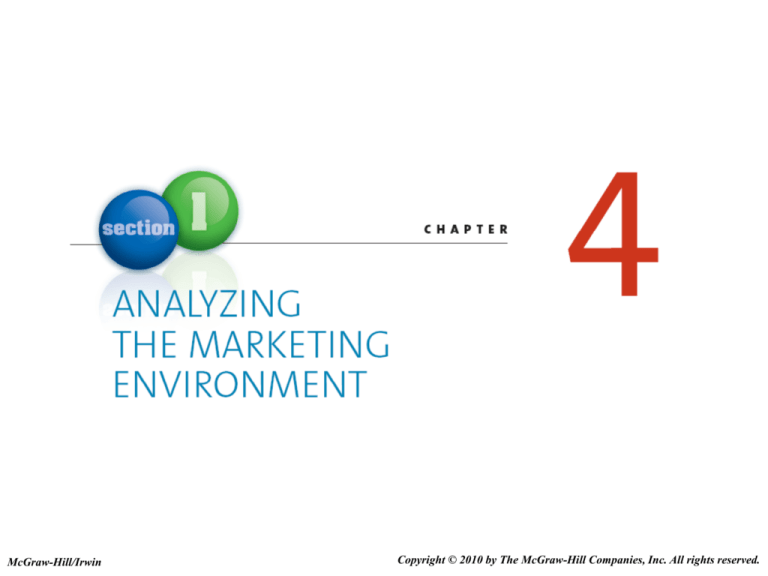
McGraw-Hill/Irwin
Copyright © 2010 by The McGraw-Hill Companies, Inc. All rights reserved.
Learning Objectives
LEARNING OBJECTIVES
How do customers, the company, competitors, and
corporate partners affect marketing strategy?
Why do marketers have to think about their macro
environment when they make decisions?
How do corporate social responsibility programs help
various stakeholders?
4-2
Analyzing the Marketing
Environment
Earth Rewards credit
card expects $20 billion
in green sales by 2010
4-3
A Marketing Environment
Analysis Framework
4-4
The Immediate Environment
4-5
Successfully Leveraging Company
Capabilities
Core competency
Existing knowledge,
facilities, patents, etc.
applied to
New markets, new
products, etc.
4-6
Competitors and
Competitive Intelligence
Competitive
Intelligence (CI)
Proactive rather than
reactive strategy
4-7
Gillette vs. Schick
4-8
Corporate Partners
•
•
•
Firms are part of alliances
Align with competitors, suppliers, etc.
Just in Time Delivery Systems (JIT)
From factory
to
Retailer
4-9
Macro Environmental Factors
4-10
Culture
Country Culture vs. Regional Culture
4-11
Demographics
Provides an easily understood snapshot of
the typical consumer in a specific target market
4-12
Generational Cohorts
4-13
Seniors, Boomers and X and Y’ers
4-14
Jeanette just joined an after-work aerobics class. She also
recently had cosmetic surgery and spent a week at rejuvenation
spa in Costa Rica. Jeanette is most probably a member of the
_________________ generational cohort.
A.
Senior
B.
Baby Boomer
C.
Generation X
D.
Generation Y
E.
Tween
4-15
Income
Purchasing power is
tied to income
Census bureau tracks
income
Many middle class
families feel the
decline in purchasing
power in recent years
$1,995.95 from
Hammacher Schlemmer
4-16
Education
=
Education is related to income,
which determines spending power
4-17
Gender
Male/female roles
have been shifting
Marketing has
changed to reflect
these shifts
4-18
Ethnicity
By 2050, minorities will
represent 50% of the
population.
Bud Light Commercial
4-19
Typical _____________ data include race,
gender, income, and marital status.
A.
behavioral
B.
macromarketing
C.
inflationary situation
D.
regional social
E.
demographic
4-20
Social Trends
Greener Consumers
Marketing to
Children
Privacy Concerns
Time-Poor Society
4-21
Greener Consumers
Customers who
appreciate firms efforts
to supply them with
environmentally
friendly merchandise.
4-22
Targeting Kids: Is it wrong?
4-23
Privacy Concerns
Loss of privacy
Identity theft
Do not call
Do not e-mail
4-24
Time Poor Society
In the majority of families, most parents work
Consumers have many more choices regarding
leisure time
Many consumers multitask
4-25
McDonald’s Moms
4-26
Technological Advances
Technology has
impacted every aspect
of marketing
New products
New forms of
communication
New retail channels
Stop and Shop Website
4-27
Economic Situation
Foreign currency
fluctuations
Combined with inflation and
interest rates affect firms’
ability to market goods and
services
Conference Board Website
4-28
Political/Regulatory Environment:
Competitive Practice and Trade Legislation
1890: Sherman Antitrust Act
1914: Clayton Act
1914: Federal Trade Commission
1936: Robinson-Putman Act
1938: Wheeler-Lea Act
1993: North American Free Trade
Agreement (NAFTA)
4-29
Check Yourself
1.
What are the six key macroeconomic factors?
2.
Differentiate between country culture and
regional culture.
3.
Identify the different generational cohorts.
4.
What key dimension is used to classify an
individual into a given cohort?
5.
What are some important social trends shaping
consumer values these days?
4-30
Corporate Social Responsibility
4-31
What are customer’s concerns?
4-32
The Output for Companies
4-33
Check Yourself
1.
How has corporate social responsibility
evolved since the turn of the 20thCentury?
2.
Identify the inputs and outputs of the
corporate social responsibility framework?
4-34
Glossary
Firms use competitive intelligence (CI) to collect
and synthesize information about their position
with respect to their rivals.
Return to slide
4-35
Glossary
Country culture involves visual nuances of a
country’s culture such as artifacts, behavior,
dress, symbols, physical settings, ceremonies,
language differences, colors and tastes, and food
preferences, as well as language.
Return to slide
4-36
Glossary
Culture is the shared meanings, beliefs, morals,
values, and customs of a group of people.
Return to slide
4-37
Glossary
Demographics indicate the characteristics of human
populations and segments, especially those used
to identify consumer markets.
Return to slide
4-38
Glossary
A generational cohort is a group of people of the
same generation.
Return to slide
4-39
Glossary
The political/regulatory environment comprises
political parties, government organizations, and
legislation and laws.
Return to slide
4-40
Glossary
Regional culture involves the region in which
people live in a particular country.
Return to slide
4-41

